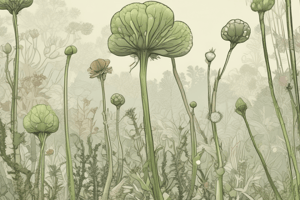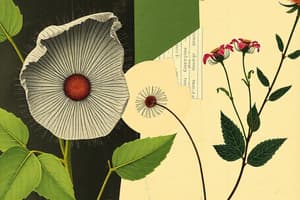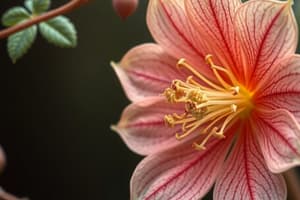Podcast
Questions and Answers
What is a key feature of the life cycle of gymnosperms?
What is a key feature of the life cycle of gymnosperms?
- Formation of fleshy fruits
- Laying eggs in water during reproduction
- Dominance of sporophyte generation (correct)
- Development of extensive root systems
Which of the following groups do seedless vascular plants NOT include?
Which of the following groups do seedless vascular plants NOT include?
- Monilophytes
- Pines (correct)
- Horsetails
- Lycophytes
How did seedless vascular plant growth during the Carboniferous period impact the environment?
How did seedless vascular plant growth during the Carboniferous period impact the environment?
- Promoted dryer climates
- Encouraged desert formation
- Contributed to global cooling (correct)
- Increased atmospheric CO2 levels
Which of the following statements about angiosperms is FALSE?
Which of the following statements about angiosperms is FALSE?
Which statement best describes the role of water in the fertilization process of seed plants?
Which statement best describes the role of water in the fertilization process of seed plants?
What is the primary function of seeds in plants?
What is the primary function of seeds in plants?
Which reproductive structure is associated with angiosperms?
Which reproductive structure is associated with angiosperms?
What type of gametophytes do seedless plants contain?
What type of gametophytes do seedless plants contain?
In bryophytes, which generation is dominant?
In bryophytes, which generation is dominant?
What is the role of rhizoids in gametophytes?
What is the role of rhizoids in gametophytes?
How do flagellated sperm travel to the eggs in bryophytes?
How do flagellated sperm travel to the eggs in bryophytes?
Which type of organism is Euglena classified as?
Which type of organism is Euglena classified as?
What process describes the transfer of DNA between bacteria via a pilus?
What process describes the transfer of DNA between bacteria via a pilus?
Flashcards
Seedless Vascular Plants
Seedless Vascular Plants
A group of plants that have true vascular systems for transporting water and nutrients, but do not produce seeds. They rely on spores for reproduction.
Sporophyte
Sporophyte
The dominant generation in the life cycle of seedless vascular plants, responsible for producing spores.
Monilophytes
Monilophytes
A lineage of seedless vascular plants that includes ferns, horsetails, and whisk ferns.
Gravity Dispersal
Gravity Dispersal
Signup and view all the flashcards
Gymnosperms
Gymnosperms
Signup and view all the flashcards
Gametophyte (Bryophytes)
Gametophyte (Bryophytes)
Signup and view all the flashcards
Bryophytes
Bryophytes
Signup and view all the flashcards
Flower
Flower
Signup and view all the flashcards
Sporophyte (Bryophytes)
Sporophyte (Bryophytes)
Signup and view all the flashcards
Archegonia
Archegonia
Signup and view all the flashcards
Antheridia
Antheridia
Signup and view all the flashcards
Rhizoids
Rhizoids
Signup and view all the flashcards
Bryophytes
Bryophytes
Signup and view all the flashcards
Study Notes
Plant Reproduction and Evolution
- Seedless plants have both male and female gametophytes in the same plant
- Seeds provide nutrients for the developing embryo, enabling plant reproduction
- Rhizoma are modified stems that store nutrients for the plant, often containing significant amounts of oil
- Stramenophiles have hairy flagella
- Dinoflagellates are major photosynthetic organisms, producing oxygen
- Angiosperms have flowers as their reproductive organs
- Conjugation involves direct DNA transfer between bacteria through a pilus
- Transformation is the uptake of free DNA by bacteria from the environment
- Transduction is the transfer of DNA mediated by a bacteriophage (virus)
Plant Structures and Functions
- Flowers are the reproductive organs of seed plants
- Seeds protect the embryo and provide nutrients for early growth and development
- Fruits enclose seeds and assist in seed dispersal
- Plant chloroplasts originated from cyanobacteria via endosymbiosis, being the only prokaryotes that generate oxygen, important in carbon and nitrogen cycles
- Chemical recycling occurs between living and nonliving components through decomposers and photosynthetic organisms involved in carbon and nitrogen fixation
- Euglena (Excavata) exhibits photosynthetic attributes
- All land plants are embryophytes
- Phylum Radiolaria are associated with crude oil formation
Bryophytes (Non-vascular Plants)
- Bryophytes (liverworts, mosses, hornworts) are the earliest diverging lineages of land plants
- Mosses thrive in moist environments and can survive extreme conditions, often found in forests and wetlands
- Rhizoids anchor gametophytes to substrates
- Sperm from antheridia require water for movement to eggs in archegonia
- Diploid sporophytes grow from archegonia and depend on gametophytes for nourishment
Vascular Plants
- Vascular sporophytes exhibit independence from gametophytes
- Vascular plants possess features like lignified vascular tissue, well-developed roots, and leaves, as well as sporophylls
- Seedless vascular plants (lycophytes and monilophytes) lack seeds
- Lycophytes include both small herbaceous and ancient large tree forms
- Seedless vascular plants contributed to global cooling during the Carboniferous period, with decayed remnants forming coal
- Water is not needed for fertilization in seed plants
Gymnosperms
- Gymnosperms are a group of seed plants with a dominance of the sporophyte generation
- They include cycads, ginkgoes, gnetophytes, and conifers
- Gymnosperms appear early in the plant fossil record and were prominent in Mesozoic terrestrial environments
- Seeds develop from fertilized ovules, and pollen facilitates sperm transfer to ovules
Angiosperms
- Angiosperms (flowering plants) are divided into magnoliids, monocots, and eudicots
- Flowers consist of modified leaves—sepals, petals, stamens (pollen), and carpels (ovules)
- Ovaries ripen into fruits, facilitating seed dispersal by wind, water, or animals
- Angiosperms originated during the Cretaceous period and now dominate terrestrial ecosystems
- Angiosperms and animal interactions (like pollination) have contributed significantly to their success
Human Dependence on Plants
- Humans rely on seed plants for various purposes, such as food, wood, and medicinal products
Studying That Suits You
Use AI to generate personalized quizzes and flashcards to suit your learning preferences.



